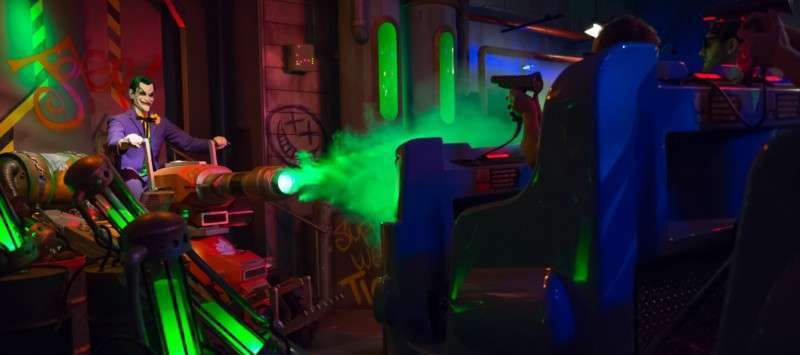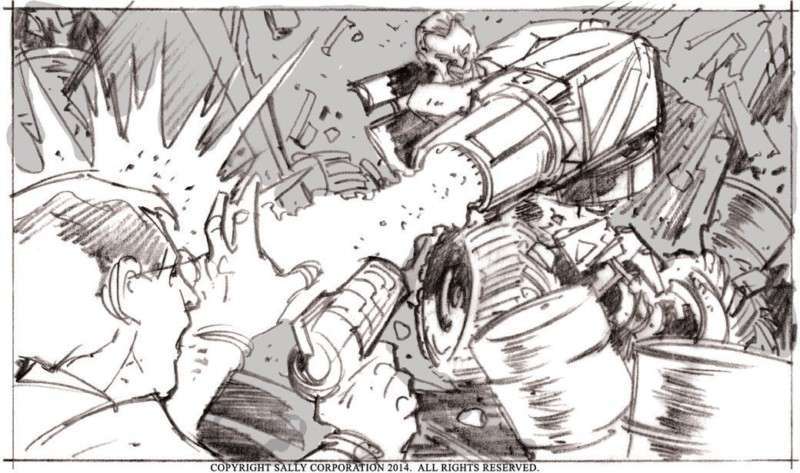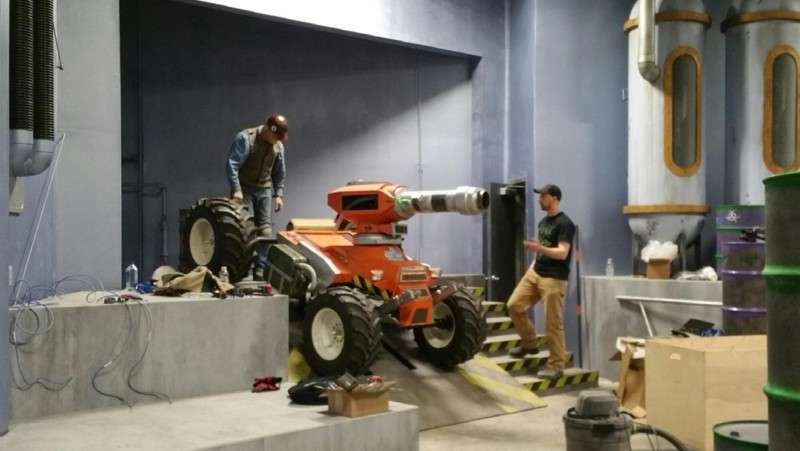By InPark’s editorial team
InPark has covered Six Flags’ Justice League attractions since they first opened in 2015. In this article, based on previous reporting from Judith Rubin and Martin Palicki, we look at the evolution of the attraction and what led to the version at Six Flags Magic Mountain being named for a TEA Thea Award.
The Thea Award for Outstanding Achievement from the Themed Entertainment Association (TEA) for JUSTICE LEAGUE™: Battle for Metropolis at Six Flags Magic Mountain is a recognition well deserved. While the Magic Mountain version is specifically the one receiving the Thea honor, it represents a series of attractions and a new direction that has helped to redefine the Six Flags franchise.
The idea for the attraction had been percolating for over a decade before the first two JUSTICE LEAGUE installations opened at Six Flags Over Texas and Six Flags St. Louis in 2015. In 2017, the seventh installation of the attraction debuted at Six Flags Magic Mountain. It’s an enhanced version of the original with the latest in technology, additional scenes and new characters.
A new generation of media-based dark rides
The ride builds on a trend that started in the late 1990s when destination theme parks began adding high-end, projection-based media dark rides with motion base vehicles. JUSTICE LEAGUE: Battle for Metropolis took that trend and made it accessible to parks and populations outside of the major theme park resorts.
Sally Corporation played the lead role of design/build contractor, starting with the conceptualization of the ride package and writing the script, to project management through installation. Sally also assembled a team of experts: Oceaneering Entertainment Systems handled the ride system,
Sally’s Rich Hill gets the superhero’s share of credit for bringing JUSTICE LEAGUE to life. As lead designer on the project he led the ride from concept through installation to opening.
Pure Imagination oversaw CGI production, Wyatt Design Group was show set designer, Lexington Design & Fabrication and Forte Specialty Contractors provided scenic construction, RealD provided the 3D projection system and the gaming system was created by Alterface Projects.
Photos on this page from the original installation of JUSTICE LEAGUE: Battle for Metropolis show the storyboard concept sketch from Sally (left), construction (right), and a photo of the ride in operation (top of page). Images courtesy of Sally
Physical + virtual
Guests enter the Hall of Justice where they learn that
several members of the JUSTICE LEAGUE (the good guys) have been captured in the
city of Metropolis. The guests are called upon to help find and free the good
guys, and capture The Joker and Lex
Luthor (the bad guys). The guests are next introduced to the ride vehicles and the technology they will use to stun villains and free the heroes.
Donning 3D glasses, guests enter the six-passenger ride vehicles to begin the adventure. According to Hill, the ride was always designed with 3D media in mind. “We wanted the characters and scenes to pop out at guests, and the best way to do that is with 3D,” explains Hill.
The ride layout takes vehicles through a series of fabricated sets and computer generated (CG) environments. With the help of lighting, effects and immersive design techniques, the physical and virtual are deftly integrated, with much of the ride environment projected onto immersive, curved screens. “We worked hard to mix the practical with the virtual,” says Hill.
“Tangible effects make a difference. And for the CG portions, we took a lot of care to make it look like virtual vistas, as opposed to just sitting in front of a TV screen.”
During the trip through Metropolis players can shoot at targets both on the screens and in the real environment, with real-time, gaming-style interaction. At the end, scores are calculated and displayed, along with a photo of each player taken earlier in the ride.
Vehicles and gear
The six-passenger vehicles for the attraction are Oceaneering’s Evo-6™ product. The JUSTICE LEAGUE attractions were the first installation of the Evo-6 ™, which is derived from an eight- passenger vehicle called Evolution, first debuted in 2005.
Each vehicle has a motion base capable of 360-degree spins (yaw) and can move at speeds up to six feet per second, although they rarely go that fast. The vehicle also contains onboard lighting and audio. Onboard audio playback comes from an Alcorn McBride AM4 Digital Audio Machine. Audio amplification comes from Alcorn’s AmpTraXX amplifier.
The gaming system is a core element of the attraction. Alterface Projects developed the patented interaction system, which is based on laser and camera detection technology. According to Alterface Projects CEO, Benoit Cornet, “This system avoids putting fragile components into the interactive devices, which means simpler and cost-effective maintenance.”
Each vehicle wirelessly transmits scoring data to a central computer located backstage. This isolates the sensitive equipment from the vibrations and movement of the ride vehicle, enhancing reliability.
The ride will continue
The attraction has exceeded expectations in all of its seven installations, and signaled a new direction for Six Flags parks. Superhero branding is not new to Six Flags, but it had, in the past, been mostly applied to roller coasters and thrill rides, which skew to younger audiences. Not only are state-of-the-art dark rides a new offering in their own right for Six Flags, they are also embraced by a much wider demographic, serving up plenty of adventure and story, but without the bumps, jolts and G-forces.
Perhaps this achievement is most impressive at Magic Mountain due to its Southern California location making it a competitor with other, formidable leisure destinations. It is a model for what smaller parks can do in the shadow of larger operators – and what inventive creative teams using modern technology can help them accomplish.
As former Six Flags Magic Mountain Park President Bonnie Sherman expressed it: “What’s exciting for us with JUSTICE LEAGUE: Battle for Metropolis here in Southern California is how we broadened our target to compete with the big players here in the theme mecca of the world. We’re kicking it up a notch with a version of this ride that’s hands-down raising the bar.”
What might be next for Six Flags, and for the team that gave us a new adventure in Metropolis? When asked about additional installations, all parties are coy. But disruptive success of this kind seems bound to engender more, and we look forward to the announcement. • • •








